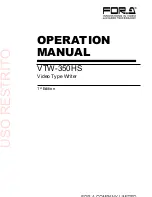
SECTION 9 |
Operation
42
9.2 POWERING ON THE LOADS
After the inverter is switched on, it takes a time to become ready to deliver full
power. Hence, always switch on the load(s) after a few seconds of switching on the
inverter. Avoid switching on the inverter with the load already switched on. This may
prematurely trigger the overload protection.
When a load is switched on, it may require initial higher power surge to start.
Hence, if multiple loads are being powered, they should be switched on one by one
so that the inverter is not overloaded by the higher starting surge if all the loads are
switched on at once.
9.3 TEMPERATURE CONTROLLED COOLING FAN
One thermostatically controlled cooling fan (18, fig 6.1c) has been provided for
forced air cooling. Temperature of a critical hot spot inside the inverter (Power
Transformer T6) is monitored to activate the fan and the over temperature shut-
down. When the temperature of this hot spot reaches 55°C ± 3°C, the fan is switched
ON. The fan will be automatically switched OFF once the hot spot cools down to 45°C
± 3°C. Please note that the fan may not switch ON at low loads or if the ambient
temperature is cooler. This is normal.
9.4 INDICATIONS FOR NORMAL OPERATION
When the inverter is operating normally and supplying AC load(s), the Green LED
marked “POWER” (2, Fig 6.1a) will be lighted. Please see Section 10 “Protections”
and Section 11 “Troubleshooting Guide” for symptoms of abnormal operation.
9.5 NO LOAD DRAW (IDLE CURRENT)
When the unit is switched ON, all the circuitry inside the inverter becomes alive
and the AC output is made available. In this condition, even when no load is being
supplied (or, if a load is connected but has been switched OFF), the inverter draws a
small amount of current from the batteries to keep the circuitry alive and ready to
deliver the required power on demand. This is called the “Idle Current” or the “No
Load Draw”. Hence, when the load is not required to be operated, turn OFF the
inverter to prevent unnecessary current drain from the battery.











































